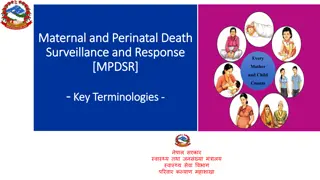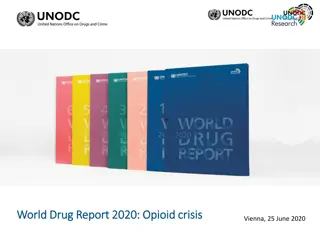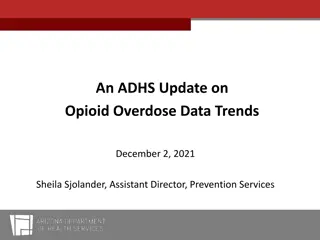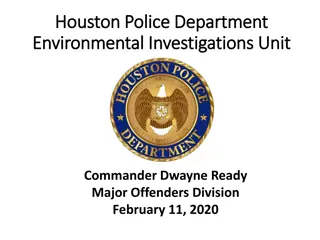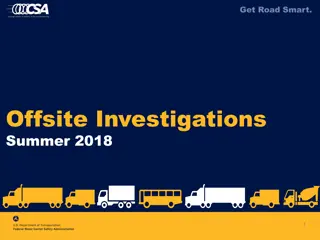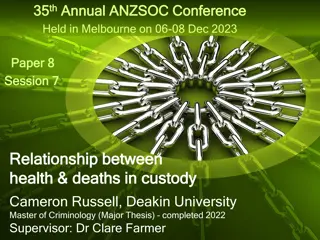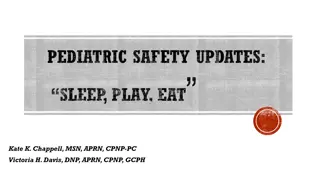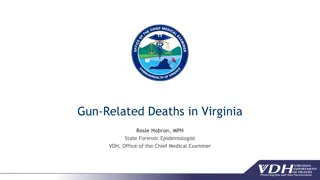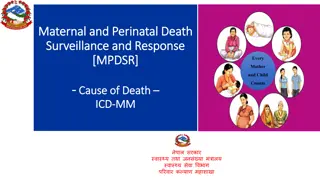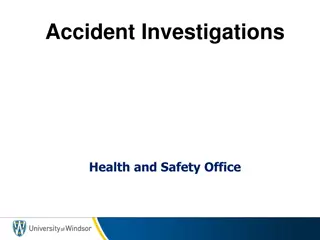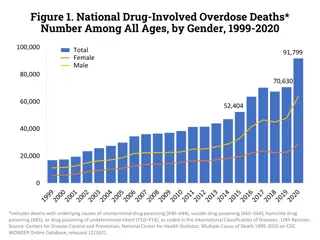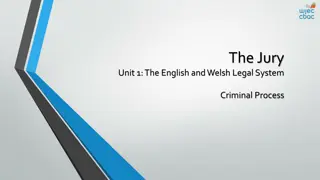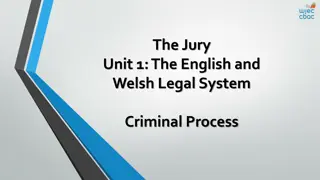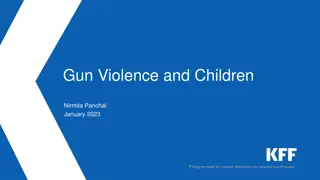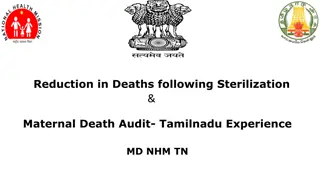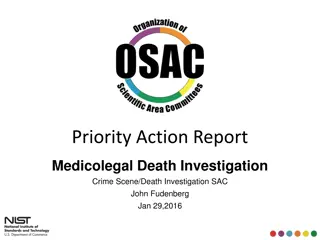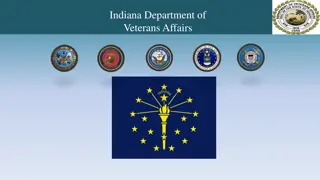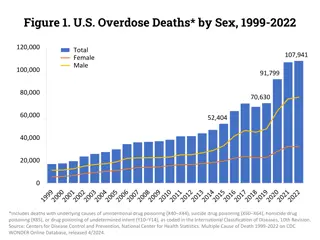Understanding Coroners' Investigations and Learning from Deaths
Explore the process of coroners' investigations, learning from deaths, and the handling of medical causes of death in England and Wales. Discover the sources of referrals to the coroner, notification of death regulations, and the various scenarios that warrant coroners' involvement. Gain insights into the roles of hospital doctors, police, and other entities in the investigation of deaths.
- Coroners Investigation
- Learning from Deaths
- Medical Causes of Death
- Referrals to Coroner
- Death Regulations
Download Presentation

Please find below an Image/Link to download the presentation.
The content on the website is provided AS IS for your information and personal use only. It may not be sold, licensed, or shared on other websites without obtaining consent from the author. Download presentation by click this link. If you encounter any issues during the download, it is possible that the publisher has removed the file from their server.
E N D
Presentation Transcript
Coroners Investigation and Learning from Deaths Andrew Harris Senior Coroner, London Inner South Professor of Coronial Law, Queen Mary London University 2ndFebruary 2023
Deaths in England and Wales 500,000 deaths E & W: Dr issues MCCD 31% reported to coroners 43% reported have autopsies 17% of reported to inquest: Coroner may enquire, investigate, inquest and issues Record and whatever stage enquiries end leads to MCCD for Registrar www.gov.uk MoJ coroner statistics 2022
Medical Cause of Death Dr should state MCD (BDRA 1953) whether or not going to coroner/pathologist, mentioning contributory causes 1c underlying caused 1b caused immediate cause 1a Antecedent cause needed: Aspiration insufficient Entries in II contribute to death, on balance of probability, but do not (directly) relate to disease in 1 To best of knowledge and belief: lower than probable Seek advice of Medical Examiner* * Requirement to take reasonable steps to determine MCD: No. 38 Guidance for RMPs on Notification Regs 2019
Source of Referrals to Coroner Hospital Doctors - apply death Notification regulations advised by MEs Police refer deaths in community, mostly unknown cause, declaration as to non suspicious A small number from other sources - Registrars, Hospices, GPs, or members of public Transfers from other coroners Directions from Chief Coroner
Notification of Death Regulations 2019* Exposure/ contact with toxic substance acute not chronic but all industrial. Implications of Kissi-Debra? Use medicinal product, psychoactive substance Violence, trauma, injury, self harm any time eg old RTA Neglect/ self neglect (lack of care ? contributed) Unexpected, mistake, procedure ? contributed Otherwise unnatural (not entirely from disease) In State Detention under mental health section MCD not known, after consultation (not with coroner) *Where reasonable cause to suspect that death is due to or contributed by, more than minimally, trivially or negligibly
Investigatory duty of Coroner Coroners and Justice Act 2009 (CJA) A senior coroner who is made aware that the body of a deceased person is within that coroners area .. if the coroner has reason to suspect that the cause is death is unknown or the deceased died a violent or unnatural death or the deceased died while in state detention (s1(2) must as soon as practicable conduct an investigation into the person s death (s1(1)) Preliminary enquiries (s1(7))
Coroners Investigations Coroner may take no further action e.g. where content that natural death but coroner notified as recent medical intervention Coroner may consult NOK and if MCD accepted by family, autopsy may be avoided and Form A issued Coroner may open autopsy at outset unnatural, MHA, industrial disease Autopsy may be ordered and if natural MCD and no reason to continue investigation, can be discontinued with Form B If investigation opened, further clinical enquiries re family concerns or possible failures in care. Decisions depend on sufficient information, submissions, advice
DEATH Cause of death natural and known Cause of death not known or unnatural NFA Refer to Coroner: enquiries Clinician issues MCCD Autopsy Open M E investigation Form A Discontinue investigation Form B Consented autopsy Open inquest Family take MCCD to Registrar of Deaths Record of Inquest sent to Registrar Cremation form Body can be collected, buried, cremated or repatriated
Unnatural medical cause: may be natural in law Where a medical intervention fails to prevent death from the underlying fatal cause, even if treatment was wrong, or negligent failure to treat, death is natural R v Birmingham Coroner ex p Benton (1997) Most deaths following emergency treatments are referred, and coroner usually finds natural Some investigation of complications in elective treatment: context sensitive how many go to inquest. Expert evidence may be needed on how ill and likely outcome before treatment and its effect
Natural medical cause may be unnatural in law Mothers BP not monitored post delivery, dying of brain haemorrhage R v Inner North London Coroner ex p Touche [2001] EWCA Civ 383;Thomas abandoned May be more than one cause, either making it unnatural ; only look for dominant cause in opening.. Look for combination of circumstances Wholly unexpected deaths from natural causes which would not have occurred but for culpable human failure Where there is a possibility of neglect , even of contributory cause, investigate if unnatural (not negligence) Only possibility of alternative cause of death needed to investigate (delay in diagnosis of septicaemia) Bloom v ADC North London v Whipps Cross Hospital [2004] EWHC 3071 (Admin)
Missed diagnosis may not need investigation Transverse myelitis. Fever, SOB, abdominal distension. Diagnosis = constipation. Unexpected death. No known cause. Autopsy: 1a small bowel ischaemia and infarction 1b Twisted mesentery Whether to open investigation depends on reason to suspect culpable human failure. Usually has distension, given antibiotics, had urgent MRI. Issued B.
High risk interventions may not be investigated PMH 70y CVA, MI, CRF awaiting renal transplant. Elective repair aneurysm with dissection. Very high risk. 1a Embolic stroke 1b AAA with dissection (operated) Bleed and CVAs during op. Not regain consciousness. Discuss with clinicians. Not unexpected. No PME. Form A. Consider main cause, time frame, level of risk, NOK views
Complications of operations investigated where unexpected or different evidence Pancreatitis. Jaundice. Cholecystectomy for gallstones. Post op ITU. Laparotomy. Family wanted earlier admission; inform of stent surgery and GI bleed not mentioned in death report PME: 1a sepsis Ib Pancreatitis and gallstones (operated) Investigation - GI bleed also cause of death from ruptured hepatic artery at surgery and pancreas necrosis; Nat causes and conseq nec medical treatment Should have had specialist biliary surgeon (PFD)
Cause of falls and NOF 81y, MI, dementia, diabetes; Fall NOF Hypotensive post op, death Day 2 1a Pulm oedema 1b IHD II NOF (operated) Osteoporosis What does coroner do? Consult NOK no concerns about care. ConsultME - Osteoporosis and old age caused Fall and NOF. Pulmonary oedema post operative. Coroner -Not unnatural as underlying natural cause. Form A
Interested Persons Statutory (S47 CJA) close relative, personal representative (includes civil partner, step-parents, half sibs) life insurer, TU if occupational, enforcing authority, IOPC, gov appointee Any person being criticized in connection with death Medical Examiner police where homicide related offence Any other C thinks has sufficient interest Ld Ch may issue guidance on IPs participation and role of Cor officers (CJA 42) Coroner must handle family distress empathetically but treat all IPs equally. Rights include notifications of autopsy, investigation, transfer, inquest, and rights to make submissions and to question witnesses
Coroners Inquest Role of Coroner is to determine answers to 4 questions (only): who, where, when and how a deceased person came by their death. How is usually by what means and not wider circumstances (A2) Coroners may therefore only investigate the quality of end of life care in cases referred to them where relates directly to cause of death. Establish why you are giving evidence to explain technical matters to give reasons for clinical decisions to answer questions from family as you are being criticised and may have contributed to death
Witness Evidence You can be compelled to give statement/ exhibit; can submit why not Make sure you know why you are called: often to explain You can be compelled to attend but have privilege against self incrimination Answer question, speak slowly, lay language, stick to your expertise, ask if poor understanding, need break The evidence is what is heard in court unless read You can be questioned by coroner and IPs; inconsistency, deviation and deception damage credibility of all your evidence
NHS Learning from deaths Internal mortality Review; MMR meetings; Clinical audit External investigations: HSIB, NCPOD, MBrace, PPO Medical Examiner coroner may ask about care deficits. Is IP. Personal learning be prepared to answer Consider self referral to professional body if appropriate Departmental or professional discipline changes SUI / RCA being replaced by Patient Safety Incident Response Framework (fewer, in depth). Cor: Witness re action plans. Interagency governance Court recognizes trauma for professionals strong learning stimulus
Coroner Preventing Future Deaths in E&W Anything revealed by the investigation gives rise to a concern that circumstances creating a risk of other deaths will occur, or will continue to exist, in the future, and (no longer similar death ) in the coroner's opinion, action should be taken to prevent the occurrence or continuation of such circumstances, or to eliminate or reduce the risk of death created by such circumstances, the coroner must report the matter to a person who the coroner believes may have power to take such action. Paragraph 7, Schedule 5, Coroners and Justice Act 2009;
E&W Regulation 28 Reports About 450 / yr, 1 in 600 inquests; 36% hospital No longer can make recommendation Complete report within 2 weeks of inquest Can copy to others e.g. Royal College, Minister Write response in 56/7, state action or why none No enforcement; Publish unless good reason Copied to IPs and Chief Coroner Regulations 28 and 29 of the Coroners (Investigations) Regulations 2013
Revisiting PFD reports Examples of failures of care or service provision Reports issued Action plans made Coroner does not learn whether medium or longer term plans come to fruition or whether necessary engagement of other agencies Ultimately unclear if beneficial change occurs until similar death represents to coroner s court
Post operative care of child of 2y Post elective op intra-tumoral haemorrhages. Astrocytoma. Failure of referral by Paed contributed Expert: poor recording GCS, late intubation, poor mgt seizures, handover. Unskilled nurses Trust non-compliant with RCN guidance on paed nursing. Not recruited to 5 posts @16/12 Paed monitoring, training, NPractnr, trigger escalation to anaesthetist, Exec recruitment campaign paed nurses DH/HEE: 6.9% gap!. Training Investment 7.4%. Has it happened?
PFD: no obstetric theatre 41/40 induced FtP; 1hr 40 mins Categ 2 LSCS Apgar 9, few PN obs; found at 2 hrs ?cause HIE contributed by neglect (lack of obs) RCOG: defined no. CTGs and theatres needed Trust: no dedicated obstetric theatre ooh, Theatre next to labour ward will be emerg 24hr Business case ODA and nurses: how successful? Increase x3 ELSC theatre sessions: reportedly has happened
Therapeutic overdose of Fentanyl in child CP aged 10 sees non UK locum in A&E R 25 mcg patch Fentanyl and discharge Who checks fitness to practice of locums, secures full past history, monitors locums? GMC: can t disclose possible concerns to Trust Trust: change pre employ checks, revalidation (introduced 2012) DH: ROs, Trust must tell CQC stds of Agency; Additional Fentanyl guidance
Nurse staffing PVD Diab, RTA- ICU low GCS. Ward: No air mattress, insuffic turns lack staff Bed sores. Sepsis. Trust: Training, Modern Matron e audit, RCAs 210 Air mattresses now 300 Different ward now for neuro patients 20: 32 nurses/beds at time now 20: 20
PFD: Alcoholic 1a Lactic Acidosis 1b Cirrhosis 1c Chronic Alc abuse. Street sleeper in A&E. Lethargic, BP 110/35. Waited for Dr. Found slumped T24, BS 0.9. Assess, observe, triage of confusional states Trust: Rapid assessment + transfer introduced, Sr Decis maker 1hr 13 av time, urine test Alc, Mental Capacity training, Temp staff induction SoS: CQI skilling, time to treatment target, NICE, med education
PFD: Inhalation of food Sex abuse alcoholic suicidal; seizure- discharge 1a Inhalation of food 1b Alc intoxication Shortage residential alcohol rehab centres Trust: complex needs dual diagnosis, motivation must be high for admittance PCT: needs assessment alcoholics service is adequate but will build more capacity
Housing for Borderline personality disorder HIE post respiratory arrest, ? Subdural haemorrhage from head banging S2 MHA chronic self harm, not psychotic No suitable housing for BPD led to deliberate self harm Collaborate on pathways and consider pilot Redesigned direct access hostel with psychologist for BPD Has interagency work borne fruit?
Prevention of Community Suicide 23yM, sui attempts, Family concern risk known, suicidal ideation by rail/jump A&E CPN discharge. 10 hrs later on rail. Trust: Awareness bulletin, new care pathway MH teams, Review Clin Risk Assessment policy 39yM, homeless, paedo, sui ideation; discharged with no record risk assess or FU; jumps under train Staff awareness, FU contact numbers. 500K investment in homeless
Physical care MH patients -antipsychotics 1. 2014 DKA: Gluc not tested 1 yr. Clinics review/ new standards set 2. 2014 Cardiac arryhthmia Need in-reach DVs by physicians 3. 2015 HONK D: Decomposed 1/12 after discharge. Neglect. GP reg, community review, audit, spvsn, Physical HC lead, commissioners, D liaison 4. HONK Olanzapine. BS 57 no insulin/fluids. 2hrs transfer A&E Physician attend MH (impossible). MEWs, new protocol; London /NCEPOD work; Need more gen nursing in RMN course
PFD: Asthma 44 yr 1a RDS 1b LRTI 1c Sleep apnoea, asthma Post dent op tachypnoea R Diazepam anxiety Vital obs not recorded, only 1 PEFR in GP records GP: clinical changes, practice meeting, prescribing and CDM system changes NHS E investigate: limited applicatn/reflection, medical records review; MDU: now bought equipment, awareness and real change
Subjects of PFD Reports LIS 2020 Need for systematic system of measuring wt in hospital; Individual Dr appraisal - not recognizing GI bleed and Hb drop was acute risk Police links with NHS MH teams when facing suicide risk Ensuring GP informed of acute deterioration in disabled child medicated with antibiotics from hospital by parents Failure to contact NOK in MHA assessment; dismissal of GP concerns of psychosis; Inadequate RCA process by Trust Need for national register of food allergy deaths; Availability of auto-injector devices
Subjects of PFD Reports LIS 2021 Prison sui 34y: Immediate needs form not completed. New system checks. Prison suspension 30y: ACCT closure, HC participation. National review. 35y ABD police restraint. Lack engagement paramedic. MPS scenario training; LAS senior assignment, digital support. Separate refer back IOPC. 63y drunk left in bus bay. Failures in risk assessment. First aid training for police in assessing breathing and consciousness Non escalation post-op deterioration 59y with sepsis. Clinical review. Delay in antibiotics for septic shock in 72y. Review of practices in Trust. 33y domestic murder. Fail info share and intervention coercive behaviour. Police review MASH processes. DWP review CMS support. 17y DV. MPS workload CSUs. Vio v F strategy. Public Protection Review
Kissi-Debra 2021 9 yr severe asthma; episodes of arrest and frequent emergency admissions: 1a) Acute respiratory failure 1b) Severe asthma 1c) Air pollution exposure Failure to reduce the NO2 to within EU domestic law limits; possibly contributed to her death from exposure to traffic 2010-13 Thousands of premature avoidable deaths every year in the UK. National limits for Particulate Matter are set far higher than the WHO guidelines. Defra, DoT and DHSC Low public awareness of sources of information about pollution. More air quality sensors. Defra, DoT, DHSC Mayor, LBL Adverse effects of air pollution poor communication to patients and carers. GMC HEC NMC; Royal Colleges, NICE, BTS
Preventing Future Deaths in E&W E&W coroners obligation to report but cannot report unless statutory criteria met Addressees must respond - and shared Targetted reports in E&W have beneficial effects especially when augmenting other initiatives No enforcement nor brought before Assembly but high media profile facilitates change No follow up or or analysis of trends Families hugely appreciative especially in NHS
Preventing Future Deaths in Australia Do not need unnatural or unknown death to - May open inquest if public interest PFD (s28) Coroner may make recommendations about public health, safety, admin justice (Cor Acts: Vic s72, Q s46 SA s25, Tas s30) C must state if public safety etc (ACT s52) W and NSW Recommendations can become statutory Actions if report to AG, goes to Assemblies (SA s25, ACT s57 (in fire may ; in disaster must ) My view: lack of academic study what is effective in PFD
Justice Select Committee Report 2021 Recommendations to MoJ June 2021. Govt: HC can amend Record, remote inquests, written inquests. Rejected: National Coroners Service, rights to Legal aid for families, fee increase for autopsy pathologists Defer: independent office/inspectorate, Charter of Rights, Appeals, PFD Re PFD reports: provide funds for information about the risks to public safety from inquests being freely available and accessible online set up an independent office to report on emerging issues raised by coroners; and liaise with regulators, eg HSE CQC Air and Rail safety bodies, to follow up on actions promised to coroners and to report publicly where insufficient action.
Conclusions Medical Examiners huge help in certification and advice to coroner, reducing unnecessary notifications to coroner. Variation in coroner practice in investigation post operative complications reflects lack of clarity in law. Family submissions key Clinicians being criticized have same rights as IPs as family High level of credibility and reliance on evidence of clinical witnesses. Should answer questions as to events and reasons for decisions, but inquest should be non adversarial. Anonymous Record, neglect v rare. Investigations/ inquests give closure to families and opportunity for prevention future death reports



